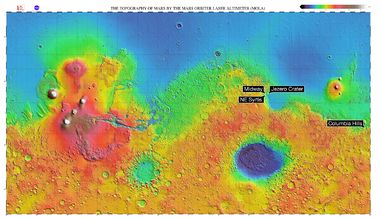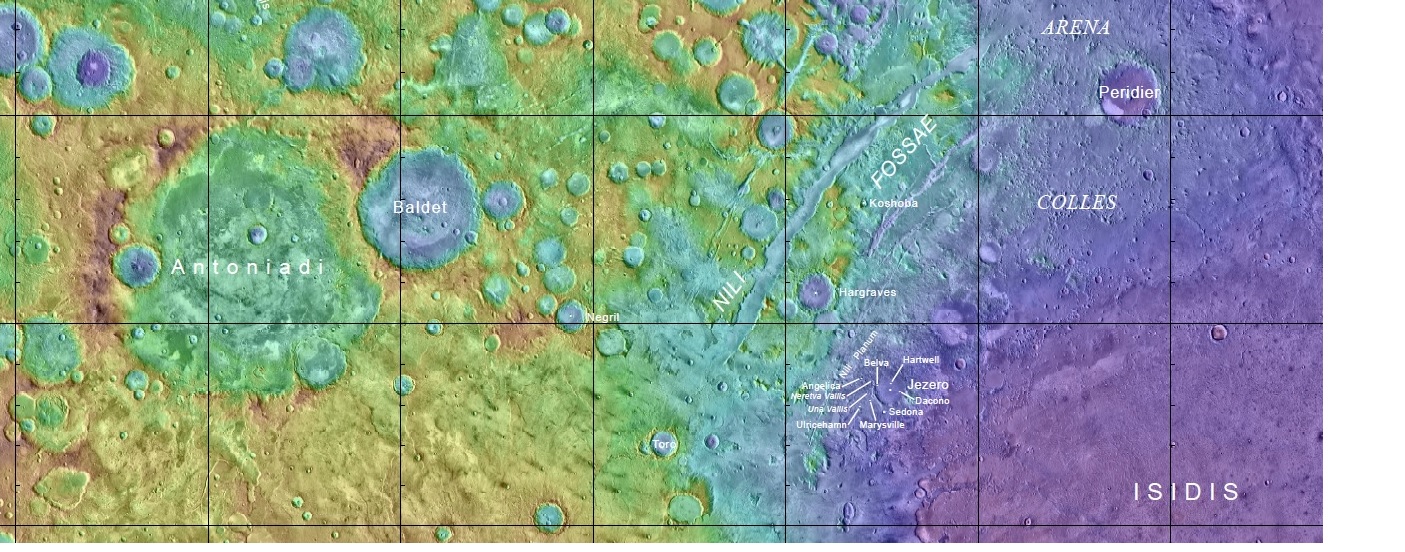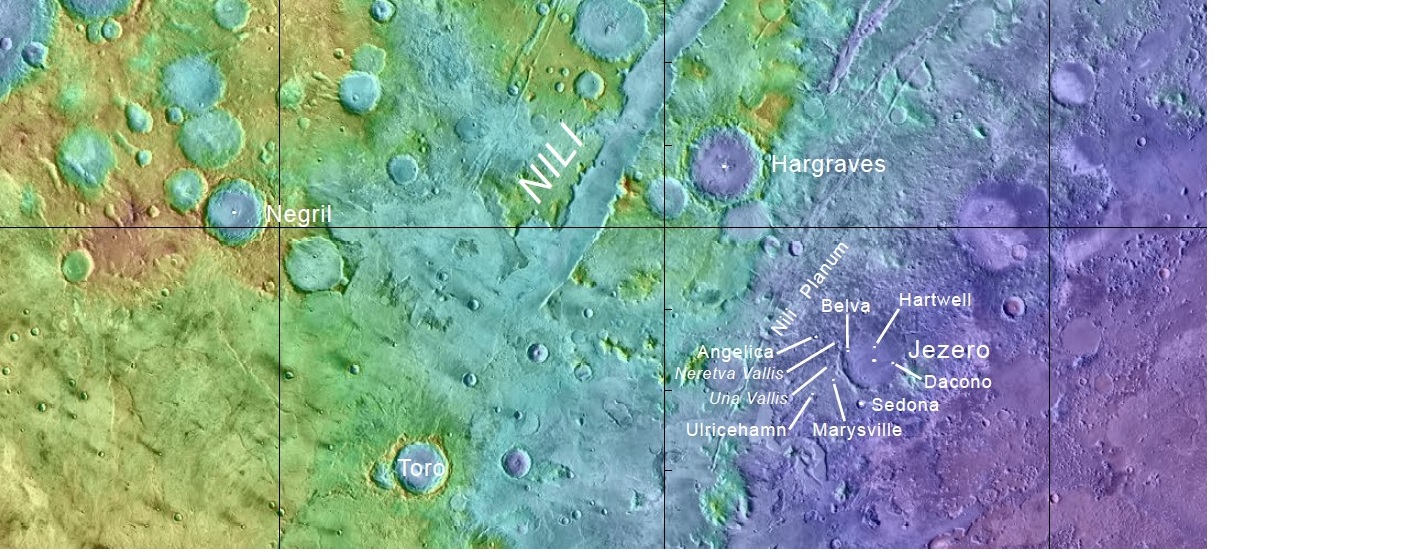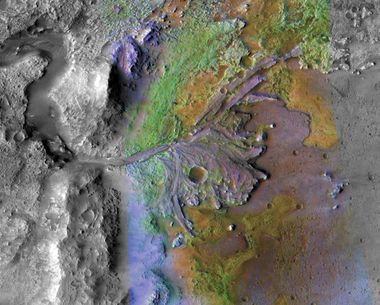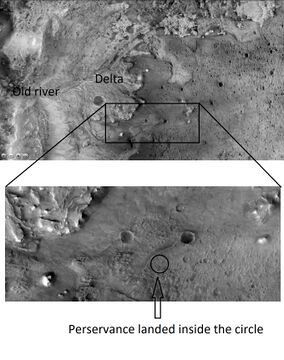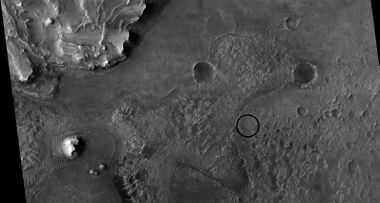Difference between revisions of "Jezero Crater"
(added image) |
m |
||
| Line 23: | Line 23: | ||
File:Jezerocloselabeledforlanding.jpg|Landing site for Perseverance Rover | File:Jezerocloselabeledforlanding.jpg|Landing site for Perseverance Rover | ||
File:ESP 045994 1985jezerocroppedcircle.jpg|Another view of landing site | File:ESP 045994 1985jezerocroppedcircle.jpg|Another view of landing site | ||
| − | File:Perseverancelandingcomposite4arrows.jpg|Views from Perseverance during landing | + | File:Perseverancelandingcomposite4arrows.jpg|Views from Perseverance during landing matched up with view from orbit with HiRISE |
</gallery> | </gallery> | ||
Revision as of 10:04, 8 March 2021
Jezero crater was chosen as the landing site for the Mars 2020 rover mission.[1] [2] [3] Perseverance was the name picked for the rover; it landed right on target near the delta on February18, 2021.[4]
Jezero is an impact crater located at 18.855 N and 77.519 E (282.481 W) in the Syrtis Major quadrangle.[5] [6] It is 47.52 Km in diameter.[7] The crater was named after one of the towns with this name in Bosnia and Herzegovina.[8]
Features near Jezero Crater
Close view of features in and around Jezero Crater
Features in Jezero Crater near delta
Distances from landing site to various features in Jezero Crater
 Possible paths for Perseverance in Jezero Crater Mesa is shown from the ground and from orbit.
Possible paths for Perseverance in Jezero Crater Mesa is shown from the ground and from orbit.
Thought to have once been flooded with water, the crater contains a fan-delta deposit rich in clays.[9] The lake in the crater was present when valley networks were forming on Mars.[10] [11] Besides having a delta, the crater shows point bars and inverted channels. From a study of the delta and channels, it was concluded that water stayed in the lake for a time; it did not experience times when the water went down. It probably formed when there was continual surface runoff.[12] Jezero Crater is found on the western edge of Isidis Planitia, which is a giant impact basin just north of the Martian equator. This location contains some of the oldest and most scientifically interesting landscapes of Mars. It is thought that Jezero may hold ancient organic molecules and other signs of microbial life because water and sediments collected in the crater billions of years ago when conditions were much more favorable for life.
A team, lead by Briony Horgan used the Compact Reconnaissance Imaging Spectrometer for Mars (CRISM), high resolution imagery, and digital elevation models, to discover places in Jezero Crater that contain carbonates. These minerals they named “Marginal Carbonates” are found along the inside margin of the crater, near the largest valley and in a delta in the west. The authors of the paper believe they were formed in an old lake in Jezero. Evidence of life could be found in these deposits by the 2020 Rover. Even large fossils of strmatolites could be present.[13] [14]
The Mars 2020 rover mission will be able to examine at least 5 types of rock, including clays and carbonates.[15] These can preserve signs of ancient life. Additional materials probably washed in from the surroundings; therefore, we will be able to determine mineral information about the area around the crater.
Rivers on the left side of Jezero carried water into the crater, while the overflow went out at the upper right.
References
- ↑ https://www.space.com/42486-mars-2020-rover-jezero-crater-landing-site.html
- ↑ https://www.jpl.nasa.gov/news/news.php?feature=7286&utm_source=iContact&utm_medium=email&utm_campaign=nasajpl&utm_content=daily20181119-2
- ↑ https://www.sciencenews.org/article/nasa-mars-2020-rover-landing-site-ancient-alien-life-river-delta?utm_source=email&utm_medium=email&utm_campaign=latest-newsletter-v2
- ↑ https://mars.nasa.gov/news/8865/touchdown-nasas-mars-perseverance-rover-safely-lands-on-red-planet/
- ↑ https://hirise.lpl.arizona.edu/PSP_007925_1990
- ↑ https://www.space.com/mars-2020-alien-life-hunt-microfossils.html?utm_source=Selligent&utm_medium=email&utm_campaign=10118&utm_content=20191116_SDC_Newsletter+-+adhoc+&utm_term=2946561&m_i=LKHS2VBMPdPBKbRsJssJ6HqkTujMa1rGRCQddp5zz8Ss3OSL%2Bdjwc5LY%2BNjlmSR30MzcdNIUCuC1q%2Bfn0ySWT1TcOiknL7DjLx
- ↑ https://planetarynames.wr.usgs.gov/Feature/14300
- ↑ https://planetarynames.wr.usgs.gov/Feature/14300
- ↑ https://hirise.lpl.arizona.edu/PSP_007925_1990
- ↑ Fassett and Head Iii, 2005 C.I. Fassett, J.W. Head Iii Fluvial sedimentary deposits on Mars: ancient deltas in a crater lake in the Nili Fossae region Geophys. Res. Lett., 32 (14) (2005), 10.1029/2005GL023456 n/a–n/a
- ↑ Fassett and Head Iii, 2008 C.I. Fassett, J.W. Head Iii. Valley network-fed, open-basin lakes on Mars: distribution and implications for Noachian surface and subsurface hydrology Icarus, 198 (1) (2008), pp. 37-56, 10.1016/j.icarus.2008.06.016
- ↑ Goudge, T., et al. 2017. STRATIGRAPHY AND EVOLUTION OF DELTA CHANNEL DEPOSITS, JEZERO CRATER, MARS. Lunar and Planetary Science XLVIII (2017). 1195.pdf.
- ↑ https://www.sciencedirect.com/science/article/pii/S0019103518306067
- ↑ Horgan, B., et al. 2019. The mineral diversity of Jezero crater: Evidence for possible lacustrine carbonates on Mars. Icarus. In press. https://doi.org/10.1016/j.icarus.2019.113526
- ↑ https://www.jpl.nasa.gov/news/news.php?feature=7539&utm_source=iContact&utm_medium=email&utm_campaign=nasajpl&utm_content=daily-20191112-1
See Also
External links
- https://www.youtube.com/watch?v=uzeQ1aha5D4 NASA's Mars 2020 Crater Will Land in Jezero Crater https://www.youtube.com/watch?v=uzeQ1aha5D4 NASA's Mars 2020 Crater Will Land in Jezero Crater
- https://www.youtube.com/watch?v=63PWQeQGfhc Layered Material Cut by a Valley Connected to East Jezero Crater https://www.youtube.com/watch?v=63PWQeQGfhc Layered Material Cut by a Valley Connected to East Jezero Crater
- https://www.youtube.com/watch?v=jev51W_j_5w HiClip mini 4K: In Praise of Jezero Crater https://www.youtube.com/watch?v=jev51W_j_5w HiClip mini 4K: In Praise of Jezero Crater
